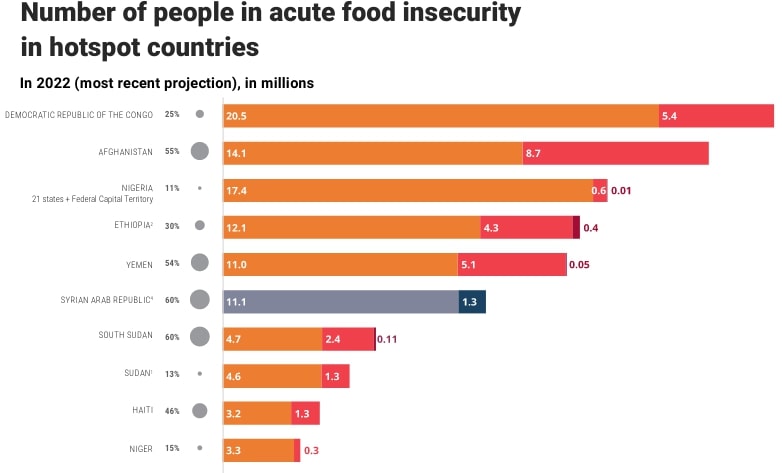
Food insecurity reaching crisis levels in 20 Hunger Hotspots
Global hunger on the rise amid a surge in food prices and higher poverty levels.
Food insecurity is on the rise around much of the world, but 20 countries in particular are ‘hunger hotspots’, according to a new report from the UN's World Food Programme (WFP) and the Food and Agriculture Organisation (FAO).
According to the Hunger Hotspots Report, Ethiopia, Nigeria, South Sudan and Yemen are the countries of highest concern, with people experiencing, or projected to experience, starvation and death – Stage 5 of the Integrated Food Security Phase Classification.
The report noted that 2021 saw an unprecedented increase in global hunger due to the rising prices of food, transportation costs, and the impact of the COVID-19 pandemic. Globally, food prices surged by 23.1% last year, according to the United Nations FAO, and are slated to rise by around 4.5% this year, although will decline in 2023. The report also attributed food insecurity to conflict and climate change.
The World Bank estimated that 97 million more people were living in poverty worldwide last year compared to 2019 due to the impact of the COVID-19 pandemic.
In the FAO-WFP ‘February to May 2022 Outlook’, the report warned of acute food insecurity levels in Ethiopia, with a high risk of famine if the conflict in the Tigray region resumes. Nearly 40% of Tigrayans face an extreme lack of food.
In Nigeria’s conflict afflicted North-East, some populations “are now projected to slide into catastrophic food insecurity at the peak of the lean season, from June 2022 onwards. [It] cannot be excluded that some may start to experience this even earlier, in the next months, and that the magnitude may be higher than what projections anticipate,” notes the report. In South Sudan, high levels of acute food insecurity are likely to increase further, the report added.
In Yemen, 11 million people, equivalent to half of all families, are consuming less calories than is needed, while the cost of a food basket in government-controlled areas has more than doubled.
 Source: WFP-FAO
Source: WFP-FAO
The report noted that food insecurity is a major concern in Afghanistan, the Central African Republic, the Democratic Republic of the Congo, Haiti, Honduras, Sudan and Syria.
Afghanistan is projected to “face a record high of people in critical food insecurity and there is a serious risk that parts of the population will face starvation and death (Phase 5) if the crisis is not contained,” the report notes. There are 22.8 million Afghans facing acute food insecurity. “By March, 8.7 million of those are expected to slide into critical levels of food insecurity (Phase 4), more than double the number from the same time last year and a record high for the country,” the report states.
The Sahel region has been added to the WFP-FAO category of countries of particular concern, including Mauritania. The report noted that region is “likely to reach the highest number of acutely food-insecure people in the past eight years under the combined effects of erratic rainfall, record high food prices and – for Central Sahel – further security deterioration.”
In Sub-Saharan Africa, the report notes that “over 10.5 million people are projected to be in Crisis or worse (Phase 3 and above), including 1.1 million in Emergency (Phase 4) between June and August 2022 – a 20% increase compared to 2021.”
The higher costs of fertilisers, which have tripled over the 18 months, has further heightened fears about food security, particularly in Africa. If African farmers forgo the buying of fertilisers, cereal production could drop by 30 million tonnes, according to Bloomberg, enough to feed 100 million people.
© SalaamGateway.com 2021 All Rights Reserved
